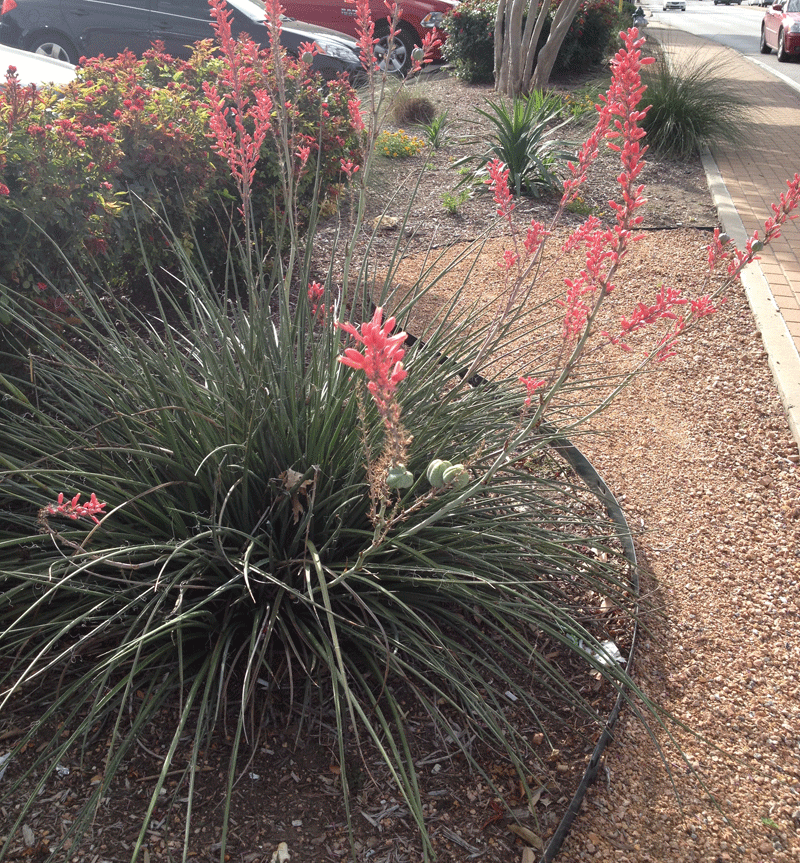Yucca
Yucca, Yucca

This tough succulent makes a striking architectural statement in any garden. Whether planted alone or en masse, yucca makes an excellent low-maintenance addition to traditional and modern landscapes.
Growing
Yucca grows best in full sun, in light, sandy, well-drained, neutral to slightly acidic soil, but it adapts to most well-drained soils. Don’t over-water, especially in winter, as plants do not tolerate soggy cold soil.
Pruning is not needed, but the flower spikes can be removed when flowering is finished, and dead leaves can be removed as needed.
Tips
Yucca looks great as an accent plant in beds, borders and foundation plantings. It also looks good as a specimen in pots, planters and urns. The variegated varieties add color and texture to beds and borders.
Recommended
Y. gloriosa is an erect, slow-growing shrub. It has 24–36" long, sword-like, blue-green to dark green leaves that arise from a basal rosette. With age, the plant develops a thick trunk and loses its lower leaves. Old plants may also develop branches, with a rosette of foliage atop each branch. The fragrant, purple-tinged, white flowers are held above the foliage on tall, spike-like clusters.
Also called: Spanish dagger, mound-lily yucca
Features: white summer flowers; striking foliage; appealing habit
Habit: rounded rosette of long, stiff, spiky, evergreen leaves
Height: 4–6'; up to 8' when flowering
Spread: 4–6'
Hardiness: zones 6–10
Sidebar: The leaves of Y. gloriosa have smooth margins and are not as stiff (or as hazardous) as those of close relatives Y. filamentosa (Adam’s needle) and Y. aloifolia (Spanish bayonet).
Yucca, Yucca

This tough succulent makes a striking architectural statement in any garden. Whether planted alone or en masse, yucca makes an excellent low-maintenance addition to traditional and modern landscapes.
Growing
Yucca grows best in full sun, in light, sandy, well-drained, neutral to slightly acidic soil, but it adapts to most well-drained soils. Don’t over-water, especially in winter, as plants do not tolerate soggy cold soil.
Pruning is not needed, but the flower spikes can be removed when flowering is finished, and dead leaves can be removed as needed.
Tips
Yucca looks great as an accent plant in beds, borders and foundation plantings. It also looks good as a specimen in pots, planters and urns. The variegated varieties add color and texture to beds and borders.
Recommended
Y. gloriosa is an erect, slow-growing shrub. It has 24–36" long, sword-like, blue-green to dark green leaves that arise from a basal rosette. With age, the plant develops a thick trunk and loses its lower leaves. Old plants may also develop branches, with a rosette of foliage atop each branch. The fragrant, purple-tinged, white flowers are held above the foliage on tall, spike-like clusters.
Also called: Spanish dagger, mound-lily yucca
Features: white summer flowers; striking foliage; appealing habit
Habit: rounded rosette of long, stiff, spiky, evergreen leaves
Height: 4–6'; up to 8' when flowering
Spread: 4–6'
Hardiness: zones 6–10
Sidebar: The leaves of Y. gloriosa have smooth margins and are not as stiff (or as hazardous) as those of close relatives Y. filamentosa (Adam’s needle) and Y. aloifolia (Spanish bayonet).


